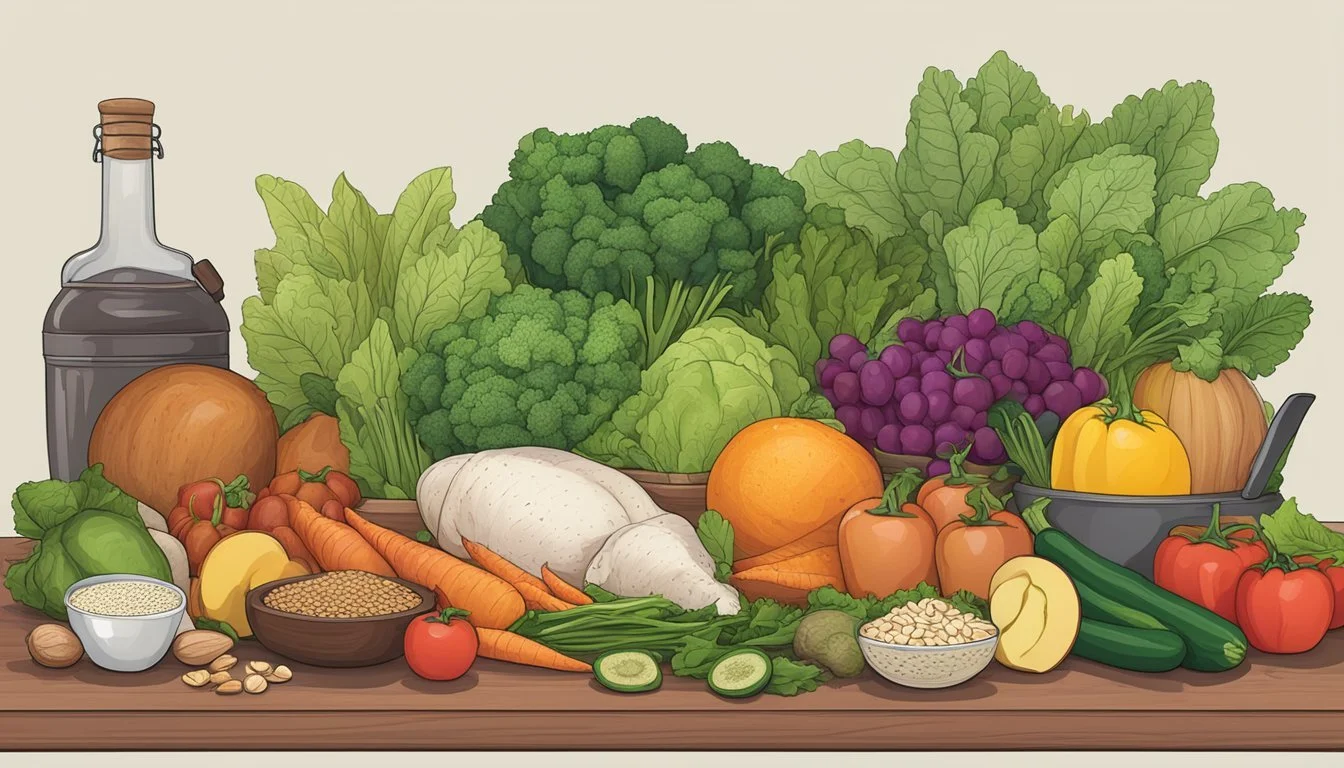Crafting the Perfect Paleo Shopping List
Essentials for a Healthy Diet
Embarking on a Paleo dietary plan requires thoughtful preparation and a strategic approach to grocery shopping. A Paleo shopping list is more than just a piece of paper; it's a guide to navigating modern supermarkets with a Paleolithic mindset. At its core, the Paleo diet emphasizes the consumption of whole foods that our hunter-gatherer ancestors would have thrived on, such as lean proteins, a vast array of vegetables, fruits, nuts (What wine goes well with nuts?), seeds, and select fats and oils. Essential to this diet is the avoidance of processed foods and most agricultural-era products like grains and dairy.
To create a successful Paleo shopping list, one must prioritize food quality and nutrient density. This means seeking out grass-fed meats, wild-caught seafood, organic produce, and healthy fat sources like avocados and coconut oil. By sticking to the outer edges of the grocery store where fresh items are typically located, shoppers can avoid the temptation of processed foods that lurk in the central aisles. It's about making intentional choices—choosing whole, unprocessed foods over convenience items that may not align with Paleo principles.
One's Paleo shopping list should also be adaptable to individual needs, seasonal availability, and personal taste preferences. While there are common staples in every Paleo pantry, there's no one-size-fits-all list. Some may include a wider variety of fruits and vegetables, while others might focus on a particular set of proteins based on their dietary requirements. The key is understanding the foundational foods that make up the Paleo diet and using them as building blocks to craft a shopping list that supports one's health and wellness goals.
Understanding the Paleo Diet Fundamentals
Before delving into crafting a Paleo shopping list, one must first comprehend the essence of the Paleo diet. It is anchored in whole foods and emulates the dietary patterns of Paleolithic hunter-gatherers.
Definition and Principles
Paleo Diet: A nutritional approach focusing on the consumption of whole foods that were available to humans during the Paleolithic era. The fundamental principles are straightforward:
Prioritize lean proteins, such as grass-fed meats and seafood.
Incorporate a diverse array of vegetables and fruits.
Include healthy fats from sources like nuts, seeds, and oils like olive and coconut.
Exclude processed foods, dairy, grains, and legumes, which are not in line with Paleolithic dietary patterns.
Benefits of Paleo Eating
Adhering to a Paleo diet offers several benefits:
Nutrient Density: Paleo foods are typically high in vitamins, minerals, and antioxidants.
Reduced Processed Sugar and Additives: By eliminating processed foods, one reduces their intake of added sugars and artificial additives.
Supports Weight Management: A focus on lean proteins and vegetables can promote satiety and help in managing weight.
Encourages Healthy Choices: The diet promotes mindful eating and preparation of foods, steering individuals toward healthier, unprocessed options.
Building Your Paleo Pantry
When transitioning to a Paleo lifestyle, curating a pantry with the right staples is fundamental. A well-stocked pantry is the backbone for preparing wholesome Paleo meals, focusing on high-quality fats, diverse nuts and seeds, essential spices and herbs, and Paleo-friendly condiments.
Essential Oils and Fats
High-quality fats are vital for cooking and flavoring food within the Paleo framework. Selections should include:
Olive oil: A heart-healthy choice ideal for dressings and low-heat cooking.
Coconut oil: Suitable for high-heat cooking and adding a subtle, sweet flavor.
Ghee: Clarified butter that is lactose-free and has a high smoke point, perfect for frying and sautéing.
Nuts and Seeds Essentials
Nuts and seeds are the go-to sources for healthy fats and proteins.
Almonds: A versatile nut that can be consumed whole, slivered, or as almond flour for baking.
Seeds: Pumpkin seeds, sunflower seeds, and chia seeds are Paleo-friendly and can be used to add crunch to dishes or as a base for homemade seed bars.
Key Spices and Herbs
The correct selection of spices and herbs enhances the natural flavors of food without the need for processed additives.
Garlic powder: Brings a concentrated burst of flavor to any dish.
Rosemary: Aromatic herb that pairs well with meats and vegetables.
Additional Spices: Cinnamon, chili powder, cumin, and paprika should have a place in your pantry for their robust flavors and health benefits.
Staple Condiments
Condiments, when chosen correctly, can provide an added layer of taste while remaining within Paleo guidelines.
Coconut aminos: A soy sauce alternative that is less salty and adds umami flavor.
Mustard: Ensure it is free from added sugars and artificial preservatives to keep it Paleo-friendly.
Selecting High-Quality Proteins
When adopting a Paleo diet, one's focus should pivot towards consuming proteins that are as natural and unprocessed as possible. This aligns with the principle of emulating the dietary patterns of Paleolithic humans.
Meat and Poultry Choices
For meats such as beef, lamb, pork, and turkey, one should prioritize grass-fed and pasture-raised options where possible. Grass-fed beef is notably higher in omega-3 fatty acids and vitamin E. Below is a list of preferred meat and poultry choices:
Chicken: Opt for organic to ensure the poultry was raised without the use of antibiotics or hormones.
Turkey: Similar to chicken, choose organic and pasture-raised selections.
Lamb and Pork: Look for labels that specify grass-fed or organic to avoid animals raised on grains and antibiotics.
Seafood Selections
Seafood, particularly fish like salmon (What wine goes well with salmon?) and shrimp, should be wild-caught to guarantee the absence of contaminants and a higher nutrient profile. Paleo-friendly seafood should be:
Salmon: Select wild-caught salmon for its high omega-3 content and absence of artificial dyes found in farmed salmon.
Shrimp: Ensure the shrimp is wild-caught for a purer product that's less likely to contain additives.
Egg Selection: Criteria and Benefits
Eggs are a staple in the Paleo diet and selecting the right type can greatly enhance their health benefits. Criteria for choosing eggs include:
Opt for organic eggs to avoid exposure to antibiotics and hormones.
If available, eggs from free-range or pasture-raised chickens are preferred for a higher omega-3 content.
Eggs provide a complete amino acid profile, making them an excellent source of protein on a Paleo diet.
Choosing the Right Produce
When embarking on a Paleo diet, selecting the right fruits and vegetables is crucial. They form the nutritional backbone of Paleo eating, emphasizing the consumption of whole foods over processed ones.
Vegetable Shopping Tips
When shopping for vegetables, one should prioritize a variety of colors and types to ensure a wide range of nutrients. Fresh, organic options are preferable as they are less likely to contain pesticides. Here is a list of essential vegetables for a Paleo-friendly kitchen:
Cruciferous Vegetables: broccoli, cauliflower, cabbage, and brussels sprouts
Root Vegetables: carrots, sweet potatoes, beets, and onions
Squash Family: zucchini, pumpkin, and butternut squash (how long does butternut squash last?)
Additional Essentials: asparagus, cucumber, avocado, garlic, and peppers
Sourcing Fresh Fruits
Fruits should be approached with mindfulness, aiming to incorporate a mix that provides various vitamins and antioxidants. Opt for organic fruits when possible, as this minimizes exposure to harmful chemicals. Here are some top fruit choices for the Paleo diet:
Berries: strawberries, blueberries, raspberries
Citrus Fruits: oranges, lemons
Stone Fruits: peaches, nectarines, plums
Pome Fruits: apples, pears
Tropical Fruits: bananas, mangoes
Melons: watermelon, cantaloupe (how long does cantaloupe last?), honeydew
By focusing on these fresh, whole foods, one can curate a Paleo shopping list that supports health and adheres to the principles of Paleolithic nutrition.
Dairy and Grain Alternatives
In constructing a Paleo diet, traditional dairy and grain products are replaced with alternative options to accommodate the dietary framework. These replacements are central to replicating the texture and nutrition profile while still adhering to Paleo principles.
Dairy-Free Options
Non-dairy alternatives that fit within the Paleo framework include beverages and spreads derived from nuts and other plant sources. Coconut milk stands out as a versatile choice for everything from cooking to coffee creamer, given its creamy texture and subtle sweetness. Almond butter, another popular choice, serves as an excellent spread or addition to smoothies, offering a good source of fats and a rich, nutty flavor.
Beverages:
Coconut milk
Almond milk
Cashew milk
Spreads:
Almond butter
Coconut butter
Non-Grain Flours and Thickeners
For baking and cooking needs, Paleo-friendly alternatives to conventional grain flours are essential. Options include coconut flour and almond flour, both of which are widely used for their binding properties and minimal impact on blood sugar levels.
Flours:
Tapioca flour
Thickeners:
Arrowroot powder
Ground flaxseed
These substitutes not only align with Paleo dietary restrictions but frequently offer added nutritional benefits such as increased fiber and protein content.
Hydration and Paleo Drinks
Staying hydrated and selecting appropriate beverages are critical components in maintaining a Paleo lifestyle. Adequate water intake is essential for overall health, while choosing Paleo-friendly drinks can complement the nutritional benefits of the diet.
Water and Its Importance
Water is the cornerstone of hydration for individuals following a Paleo diet. It plays an indispensable role in bodily functions, including digestion, absorption, and transportation of nutrients. A rule of thumb is to consume a volume of water in ounces equivalent to half of one's body weight in pounds. For instance, a person weighing 150 pounds should aim for 75 ounces of water per day.
Paleo-Friendly Beverages
Beyond water, adherents to the Paleo diet can enjoy several other hydrating options. The emphasis is on natural, unprocessed beverages without added sugars. Here's a list of Paleo-approved drinks:
Tea: Naturally caffeine-free herbal teas or traditional varieties without additives align with Paleo principles.
Coconut Water: It's a hydrating drink rich in electrolytes, ideal for post-workout recovery.
Drinks with Natural Sweeteners: Using stevia or raw honey in moderation can sweeten beverages without refined sugars.
One should always carefully read labels to ensure that ingredients are Paleo-compliant and avoid artificial sweeteners and flavorings. These regulations help maintain the integrity of one's Paleo diet and support a healthy lifestyle.
Snacking on Paleo
Embracing a Paleo diet does not mean one has to sacrifice delicious snacks. The key is focusing on nutrient-dense options that align with Paleo principles—whole foods that are minimally processed.
Healthy Snacks and Treats
Selecting snacks that fit into the Paleo lifestyle involves choosing foods close to their natural state. Ideal Paleo snacks are both satisfying and beneficial to health.
Nuts and Seeds: They are excellent sources of healthy fats, protein, and fiber. Common Paleo-friendly choices include:
Almonds
Hazelnuts
Walnuts
Pumpkin seeds
Sunflower seeds
Fruit: When it comes to fruit, those adhering to Paleo often reach for:
Berries (such as strawberries, blueberries, and raspberries)
Citrus fruits (like oranges and grapefruits)
Bananas (best enjoyed in moderation due to high sugar content)
Avocado (rich in healthy fats)
These options provide a wealth of vitamins, antioxidants, and fiber.
Preparation Tips for Snacks
Organizing Paleo snacks for convenience can help maintain this dietary choice throughout a busy day. Here are a few tips:
Portion out nuts and seeds ahead of time to prevent overconsumption.
Pair fruit with a handful of nuts to balance macronutrients for a more satisfying snack.
Use glass containers or BPA-free plastic bags to preserve freshness and make snacks easily transportable.
Maintaining a Paleo diet is simple with the right choices and a bit of preparation. Integrating these snacks into one's diet can offer a great way to stay energized and adhere to Paleo principles.
Planning and Shopping Efficiently
Efficient paleo shopping hinges on a well-crafted list and budget-conscious planning. They ensure shoppers purchase nutrient-dense, seasonally available foods while avoiding unnecessary spending.
Creating a Master Shopping List
One's master shopping list is the cornerstone of efficient paleo shopping. It should detail every item needed to prepare the week's recipes. Lean proteins, fresh vegetables and fruits, healthy fats like nuts, seeds, and oils, and a variety of spices form the crux of a paleo shopping list. It's advised to construct the shopping list at home, away from the influences of store advertising.
Budgeting and Seasonal Buys
Budgeting plays a critical role in one's grocery shopping routine. Shoppers must prioritize items that align with both their meal plans and financial constraints. Purchasing seasonal produce can lower expenses and add nutritional variety. One should be mindful of sales and bulk buying options for non-perishable staples. By incorporating seasonal items into their recipes and list, shoppers can enjoy a richer array of flavors while adhering to their budget and paleo guidelines.
Recipes and Meal Ideas
Crafting a Paleo shopping list is more efficient when one has specific recipes and meal plans in mind. This approach ensures that all purchases contribute to a well-rounded and diverse set of meals for the week.
Simple Paleo Recipes
Breakfast: Fiesta Eggs
2 eggs (fried or scrambled)
Mixed vegetables (peppers, onions, tomatoes)
Lunch: Meatballs & Mixed Greens Salad
Homemade paleo meatballs
Mixed greens
Olive oil and lemon juice dressing
Dinner: Paleo Taco Salad
Ground meat (beef or turkey)
Greens (lettuce or spinach)
Paleo taco seasoning
Diced tomatoes
Sliced olives
These recipes incorporate whole foods with a focus on vegetables, proteins, and healthy fats, adhering to Paleo guidelines. They avoid processed foods and grains, ensuring a nutrient-dense meal plan.
Batch Cooking and Meal Prepping
Batch cooking enables one to prepare meals in large quantities, which saves time throughout the week. One can cook a larger portion of protein, like Kalua Pig or Korean Short Ribs, to be repurposed in subsequent meals.
Meal Prepping Idea:
Day Meal 1 (Lunch) Meal 2 (Dinner) Monday Kalua Pig with sweet potato mash Kalua Pig with Asian Cauliflower Rice Tuesday Leftover Korean Short Ribs Korean Short Ribs with steamed broccoli Wednesday - -
Condiments such as homemade mayonnaise or mustard can be made in advance and used throughout the week to add flavor to meals without the added sugars found in many store-bought versions.
By prioritizing batch cooking and meal prepping, individuals can streamline their food preparation process, reduce waste, and enjoy a variety of meals with minimal daily effort.









